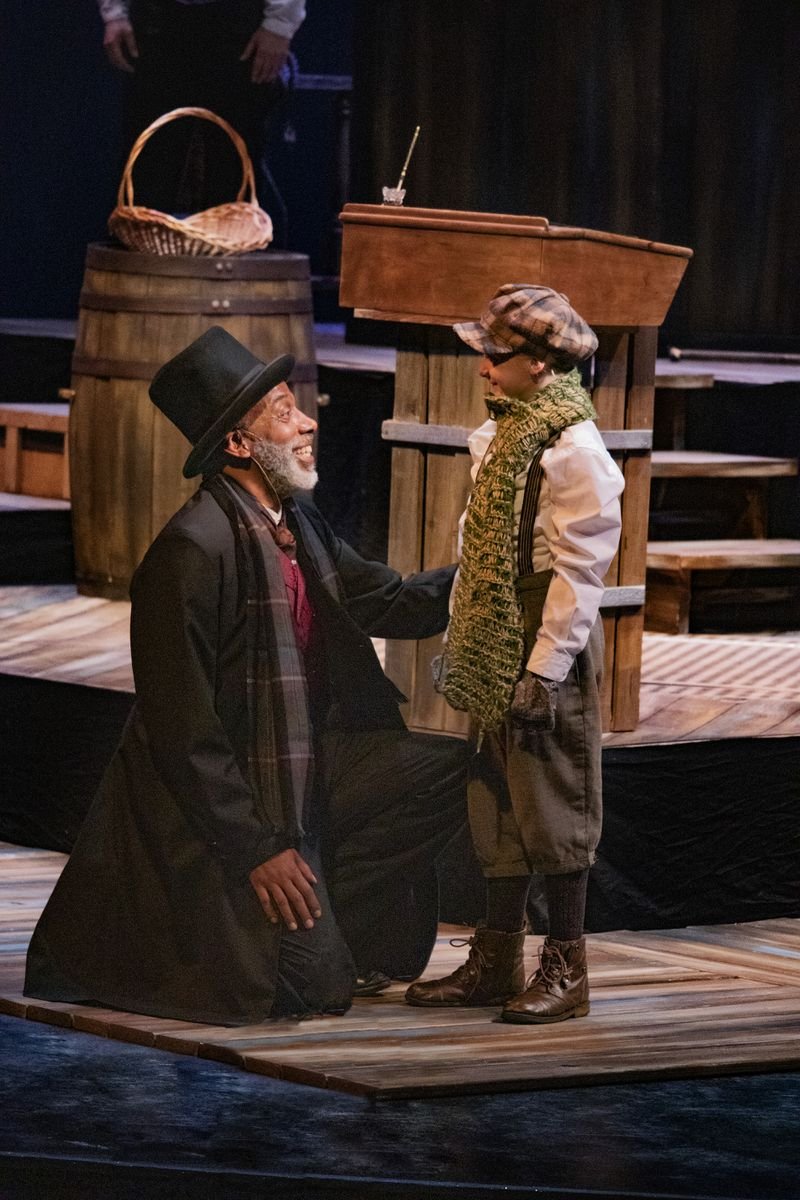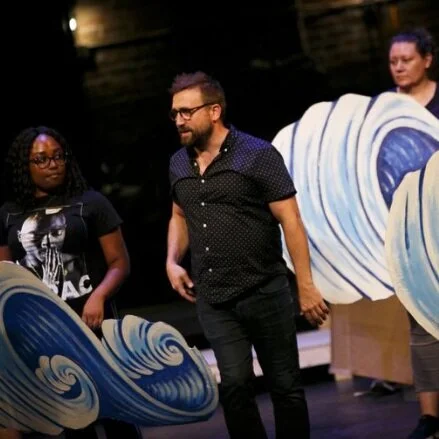Marley may have been dead to begin with, but A Merry Little Christmas Carol at the Virginia Stage Company’s historic Wells Theatre is full of life.
Small cast, big story in Virginia Stage Company’s ‘A Merry Little Christmas Carol’
The heavy fog that descends on the Wells Theatre stage announces that the Virginia Stage Company’s “A Merry Little Christmas Carol” will be a play of atmosphere and moods…there is an eeriness in any ghost story, and Dickens’ “A Christmas Carol,” from which this script is adapted, is arguably the English-speaking world’s favorite ghost story. While it has plenty of the expected suspense and hints of tragedy, this version of the three Christmas spirits reforming the old miser Ebenezer Scrooge is dominated by high-spirited joy, laughter and ebullient glee.
Virginian-Pilot: Arts Need Support
Virginia Stage Company to Receive $20,000 Art Works Grant from the National Endowment for the Arts for Public Works Virginia Project
Virginia Stage Company has been approved for a $20,000 Art Works grant to support a world premiere theater production by Ronve O'Daniel and Jevares Myrick, co-creators of contemporary hip-hop musical Once Upon A Rhyme: A Musical Tale. Mr. O’Daniel and Mr. Myrick will write a hip-hop musical that will serve as both education and a celebration of the unique history of the Hampton Roads community.
VIRGINIAN-PILOT: VSC mines Austen’s ‘Sense and Sensibility’ for comedy gold
The Virginia Stage Company’s production of “Sense and Sensibility” tells you immediately that Jane Austen is in for a modern makeover…Yes, this will be Austen’s familiar tale of the Dashwood sisters, who must navigate the waters of wealth, class, heartbreak and love in 1790s England. But it will be told in a raucous way that aims for laughter more than drama, and gets plenty of it.
VEERMag: Finding Balance in Sense & Sensibility
Student, professor collaborate to tell stories with scenic design
Student, professor collaborate to tell stories with scenic design
by Kristen Popham ’20 |
December 19, 2019
William & Mary Online
For Maloni Wright ’21, it was an opportunity to combine a passion for details, design and arts with preparation for a post-graduate path. For Associate Professor of Theatrical Design Matthew Allar, it was a chance to bring projects to their realization while investing in a future stage designer.
Together, their research collaboration in scenic design has brought stories to life. This year, Wright, a double major in theatre and philosophy at William & Mary, decided to take her classroom learning to the next level. After taking two theatrical design classes taught by Allar, developing skills in drawing, painting, drafting and model building based on hypothetical theatrical productions, Allar invited her to take on a role as his assistant. Now, she is aiding in the design of professionally produced work.
“Over the course of a couple of semesters, it was clear that Loni’s aptitude for design work made her a great fit for this kind of project,” said Allar.
What began as a final project assignment to design a set for an imaginary production of “Detroit ’67” transformed into Wright’s assistance in the scenic design for Virginia Stage Company’s professional production of “Detroit ’67” just one year later. The key to Wright’s unique proclivity for research, model-building and theatrical design? It’s all in the details.
“On things like this, the details are key,” she said. “It’s the difference between having something be OK and something be perfect.”
In Wright’s role as an assistant, she begins by sifting through the script with Allar with what she describes as “a fine-tooth comb.” In her work on “Detroit ’67,” she engaged in extensive research on everything from the type of Christmas tree lightbulbs typical of the period to the model and brand of washing machine most matched to the family’s class. Her research was a scavenger hunt to ask the right questions and to tell other people’s truths, she said.
“We know it’s set in 1967, but what’s this family like? What’s their socioeconomic status? For this family, we’re not looking for new things from 1964, we’re looking for things from later on in the ’50s,” she said.
Allar emphasized the importance of Wright’s work in completing the picture of a performance’s story.
“One key takeaway is in this level of work in theatrical design, we’re really striving toward perfection – not just in terms of model building or drafting or technical drawing, but in terms of idea,” Allar said. “There’s a large number of audience members who have a very first-hand relationship to this, so it ramps the stakes up that much higher to get it right.”
After initial research, Allar and Wright dive into model-building, where their concern for detail endures. Wright transforms sketches into model sets that are delicately built to-scale. It’s this area of design work where Wright has confronted the most challenges and observed the most improvement, she said.
“My biggest challenge is cutting, because everything is so small. If it doesn’t work, you need to start over and do it again.” Wright said. “But one of the biggest rewards is — since we’re working with shops that aren’t near us — if there’s a problem with anything, we find it when we’re making (the models) before they use actual lumber and actual structures that can’t so easily be taken apart.”
Wright explained she is grateful for the opportunity to learn in a space where her failure is accepted and her improvement is fostered.
“This is the opportunity for me to learn those things in a safe space where if I mess up, it’s OK,” she said.
After this process of careful research, design and iteration, the team’s work takes to the stage. By the end of their year of research collaboration, Wright and Allar will have collaborated on three produced works. Wright will also speak on a discussion panel at the United States Institute of Theatre Technology’s national conference in April 2020.
“This is another outlet for her to feel like her work is not just being seen on campus, but seen across the country,” said Allar.
For Wright, the significance of her research extends beyond pre-professional preparation or national recognition. It’s about doing justice to people’s stories, she said.
“These stories are what people live through, and people are very particular when you’re talking about their lives and their experiences. We have to be careful that we don’t diminish those experiences or incorrectly portray them,” said Wright. “What we do in our research and in building the models is make sure we are taking the care to correctly tell those stories.”
THE VIRGINIAN-PILOT: Themes of ‘Detroit ′67’ pack a punch decades later
For five days in 1967, Detroit was embroiled in dissension. Rebellion was in the air and city streets resembled war zones. Considered part of the national riots known as the “long, hot summer of 1967,” unrest in Detroit began when the police department raided an unlicensed, after-hours bar on the city’s West Side. This week, the Virginia Stage Company begins to bring that chaos and conflict to the stage in its production of “Detroit ′67.”







